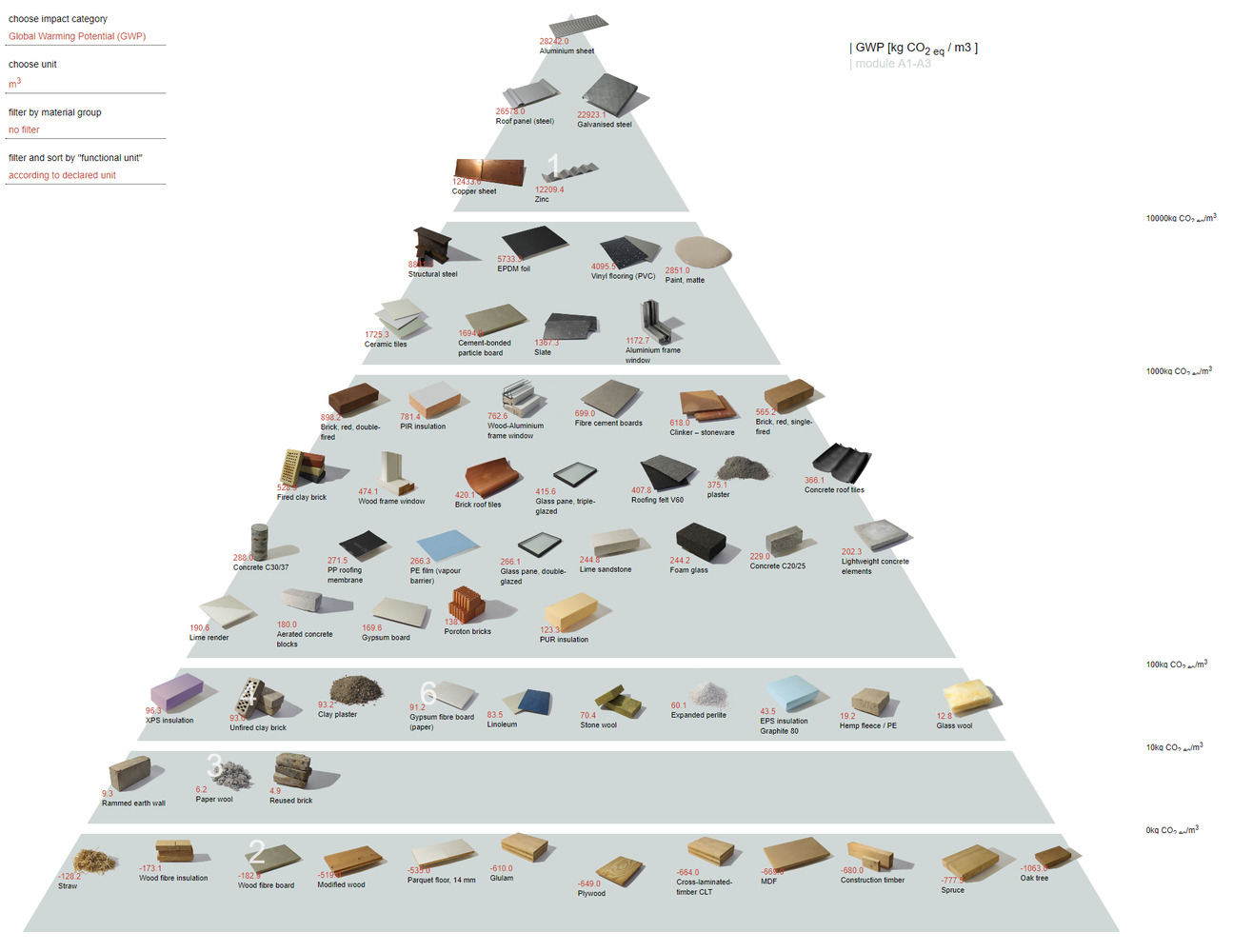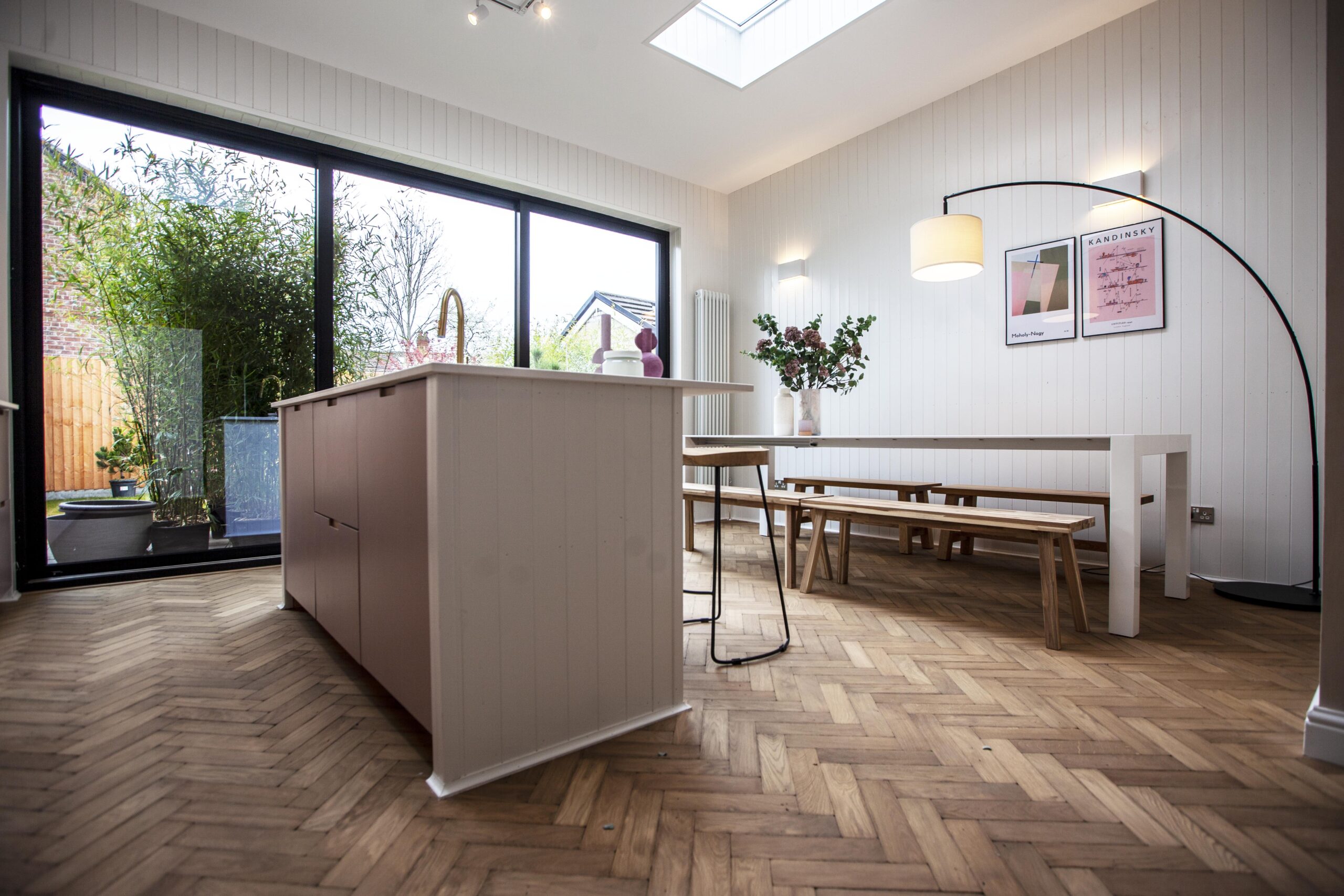
No wonder wood floors bring warmth, luxury and well-being into our homes.
As with all design choices we make these days, we need to balance our desire for gorgeous aesthetics with the environmental impact of the resources we consider using.
Wood flooring has a shallow environmental impact.
Because of the reforestation initiatives, the benefits trees bring to the world during their lifetime, and the end product’s reusability, wood flooring can have a negative carbon footprint at its best.
This claim is supported by the Royal Danish Academy’s Center for Industrialised Architecture (CINARK), which developed the Construction Material Pyramid.
This infographic has been created to highlight the environmental impact of the most used construction materials.
It is designed to be easy to understand and, therefore, can help designers and architects communicate the environmental impact of consumers’ choices with their clients.
Clients can use this information to make informed decisions from the planning phase of their design on the environmental impact of their choices, starting with the extraction of raw materials through to the impacts of transportation and manufacturing.
The study looks at each product’s ecological and environmental credentials and measures them in several categories.
The study shows the minimal impact wood has on its environment and, in many cases, how it benefits the environment.
Global Warming Potential
The GWP is another way of referring to a product’s carbon footprint.
CINARK tell us, “When it comes to the potential to cause future harm to the health of our planet, organic materials have been shown to have negative rates, which means they absorb more greenhouse gases than they produce during their manufacturing.”
The positive impact of wood flooring doesn’t just impact the external environment – our homes are benefitted too.
Wood floors remove toxins from the air once inside our homes, meaning the protection provided by trees can continue and look after our families’ wellbeing when we bring wood floors into our homes.
Ozone depletion potential – ODP
In addition to measuring the carbon footprint of materials, CINARK’s analysis also considers the products’ potential to damage our ozone layer.
Those of a certain age will remember the banning of CFCs in the 1990s once the discovery was made about the damage they were causing.
Nowadays, products causing the most harm to our ozone layer are thermal insulators.
At the other end of the scale, materials that require low processing, such as wood, stones and copper sheets, have virtually no potential for ozone depletion.
Photochemical Ozone Creation Potential – POCP
We have often discussed the biophilic nature of using wood in our homes, and POCP can help us understand the science of biophilia.
In high concentrations, ozone can affect the health of humans and nature and may even affect breathing.
Wood has the lowest POPC level of all analysed building materials, which could help us understand why we feel so much better in homes built from materials that absorb carbon rather than produce it.
Acidification Potential – AP and Eutrophication Potential – EP
Measuring Acidification and Eutrophication helps us understand how soil nutrients are affected.
By looking at how specific materials’ production and manufacture impact ecosystems, we can make choices which safeguard their finely balanced nutrients.
Unsurprisingly, wood floor products have very low AP and EP.
These low levels help to safeguard soil health which is vital for our agricultural industries and food production.
Products, such as wood and straw, which are nestled at the pyramid’s base, ensure this bedrock remains safe.
Keeping the impact low
Unsurprisingly, oak trees, modified wood, construction timber and plywood are at the bottom of this pyramid, alongside other natural resources such as straw and manufactured products, including MDF.
This study shows how much lower wood flooring’s environmental impact is than those of concrete, lime sandstone, glass and even brick, which all appear at least two rungs higher on CINARK’s Construction Material Pyramid than wood.
Most beautiful of all, wood can have negative C02 rates from its first use, but the carbon footprint of building materials reduces even further, and the benefits increase even more with each subsequent reuse.
Long-term impact on our homes
Wooden or hardwood flooring also comes with the added advantage of improving indoor air quality by absorbing and storing carbon from the air.
Helping more than just our air quality, wood flooring’s naturally insulating properties can also help your home to consume less energy.
Since you save on energy utilisation, you directly contribute to energy conservation, which contributes towards a greener environment.
With their potential to be refinished to keep up with your evolving home design choices and personal style, wood floors can reduce waste as they are far less likely to need to be disposed of.
Even after you have exhausted the use of hardwood floors, they can still be reused time and time again.
Summary
- Wood flooring has a shallow impact on the environment
- Wood floors can be carbon-neutral or even carbon negative
- Wood flooring helps keep homes energy efficient
- Wood floors can be reused and recycled, contributing to green and circular economies.
- Wood floors are suitable for individuals and have a minimal impact on the planet.













